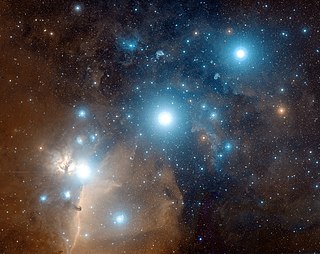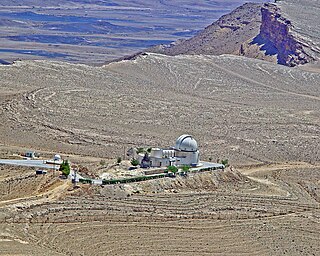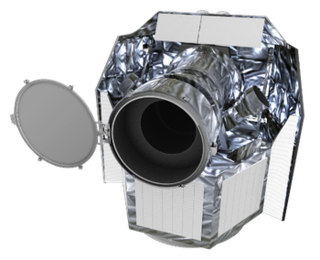
Astrophotography, also known as astronomical imaging, is photography of astronomical objects, celestial events, and areas of the night sky. The first photograph of an astronomical object was taken in 1840, but it was not until the late 19th century that advances in technology allowed for detailed stellar photography. Besides being able to record the details of extended objects such as the Moon, Sun, and planets, astrophotography has the ability to image objects invisible to the human eye such as dim stars, nebulae, and galaxies. This is done by long time exposure since both film and digital cameras can accumulate and sum light photons over these long periods of time.

Photometry, from Greek photo- ("light") and -metry ("measure"), is a technique used in astronomy that is concerned with measuring the flux or intensity of light radiated by astronomical objects. This light is measured through a telescope using a photometer, often made using electronic devices such as a CCD photometer or a photoelectric photometer that converts light into an electric current by the photoelectric effect. When calibrated against standard stars of known intensity and colour, photometers can measure the brightness or apparent magnitude of celestial objects.

XMM-Newton, also known as the High Throughput X-ray Spectroscopy Mission and the X-ray Multi-Mirror Mission, is an X-ray space observatory launched by the European Space Agency in December 1999 on an Ariane 5 rocket. It is the second cornerstone mission of ESA's Horizon 2000 programme. Named after physicist and astronomer Sir Isaac Newton, the spacecraft is tasked with investigating interstellar X-ray sources, performing narrow- and broad-range spectroscopy, and performing the first simultaneous imaging of objects in both X-ray and optical wavelengths.

A refracting telescope is a type of optical telescope that uses a lens as its objective to form an image. The refracting telescope design was originally used in spy glasses and astronomical telescopes but is also used for long-focus camera lenses. Although large refracting telescopes were very popular in the second half of the 19th century, for most research purposes, the refracting telescope has been superseded by the reflecting telescope, which allows larger apertures. A refractor's magnification is calculated by dividing the focal length of the objective lens by that of the eyepiece.

An optical telescope is a telescope that gathers and focuses light mainly from the visible part of the electromagnetic spectrum, to create a magnified image for direct visual inspection, to make a photograph, or to collect data through electronic image sensors.

The Kepler space telescope was a space telescope launched by NASA to discover Earth-size planets orbiting other stars. Named after astronomer Johannes Kepler, the spacecraft was launched on March 7, 2009, into an Earth-trailing heliocentric orbit. The principal investigator was William J. Borucki. After nine and a half years of operation, the telescope's reaction control system fuel was depleted, and NASA announced its retirement on October 30, 2018.

A Schmidt camera, also referred to as the Schmidt telescope, is a catadioptric astrophotographic telescope designed to provide wide fields of view with limited aberrations. The design was invented by Bernhard Schmidt in 1930.
The Trans-Atlantic Exoplanet Survey, or TrES, used three 4-inch (10 cm) telescopes located at Lowell Observatory, Palomar Observatory, and Teide Observatory to locate exoplanets. It was made using the network of small, relatively inexpensive telescopes designed to look specifically for planets orbiting bright stars using the transit method. The array used 4-inch Schmidt telescopes having CCD cameras and automated search routines. The survey was created by David Charbonneau of the Center for Astrophysics, Timothy Brown of the National Center for Atmospheric Research, and Edward Dunham of Lowell Observatory.

The Astronomical Observatory of Belogradchik or Belogradchik Observatory is an astronomical observatory owned and operated by the Institute of Astronomy of the Bulgarian Academy of Sciences. It is located near the town of Belogradchik in northwestern Bulgaria, at the foot of the Western Balkan Mountains. The other observatory operated by the same institute is the Rozhen Observatory.

The Florence and George Wise Observatory is an astronomical observatory owned and operated by Tel Aviv University. It is located 5 km west of the town of Mitzpe Ramon in the Negev desert near the edge of the Ramon Crater, and it is the only professional astronomical observatory in Israel.

The Vainu Bappu Observatory is an astronomical observatory owned and operated by the Indian Institute of Astrophysics. It is located at Kavalur in the Javadi Hills, near Vaniyambadi in Tirupattur district in the Indian state of Tamil Nadu. It is 200 km south-west of Chennai and 175 km south-east of Bangalore.

Shamakhy Astrophysical Observatory is an observatory in the Caucasus Mountains in Azerbaijan. It is named after Nasreddin Tusi (Shao). It is located on the eastern slope of Pirqulu, at an elevation of 1500 m. It has 150–200 clear, cloudless nights per year.

Kepler-7b is one of the first five exoplanets to be confirmed by NASA's Kepler spacecraft, and was confirmed in the first 33.5 days of Kepler's science operations. It orbits a star slightly hotter and significantly larger than the Sun that is expected to soon reach the end of the main sequence. Kepler-7b is a hot Jupiter that is about half the mass of Jupiter, but is nearly 1.5 times its size; at the time of its discovery, Kepler-7b was the second most diffuse planet known, surpassed only by WASP-17b. It orbits its host star every five days at a distance of approximately 0,06 AU. Kepler-7b was announced at a meeting of the American Astronomical Society on January 4, 2010. It is the first extrasolar planet to have a crude map of cloud coverage.

Kepler-9d is a planet in orbit around the sun-like star Kepler-9. Initially discovered by Kepler spacecraft, a terrestrial planet-searching satellite built and operated by NASA, Kepler-9d is most likely a Super-Earth, with an estimated radius approximately 60% larger than that of Earth's, although its exact mass cannot be determined. Kepler-9d orbits Kepler-9 every 1.56 days at a distance of .0273 AU from its star, an extremely close distance. Although Kepler-9d is the closest planet to its star in its system, it is named Kepler-9d instead of Kepler-9b because two gas giants, Kepler-9b and Kepler-9c, were confirmed first. The original studies into the system first suggested that Kepler-9d might be a planet, but a follow-up investigation made by the Kepler team later confirmed that it was; the confirmation of Kepler-9d as a planet was made public with the team's paper, which was published in the Astrophysical Journal on January 1, 2011. The team used telescopes at the W.M. Keck Observatory in Hawaii to follow up on the Kepler space telescope's initial discovery.

The ÇOMÜ Ulupınar Observatory (UPO) is a ground-based astronomical observatory, which was established in 2001 and formally opened on 19 May 2002. It is also known as Çanakkale Observatory or the University Observatory. The Ulupınar Observatory is part of the Çanakkale Onsekiz Mart University (ÇOMÜ) Faculty of Science and Arts.

CHEOPS is a European space telescope. Its objective is to determine the size of known extrasolar planets, which will allow the estimation of their mass, density, composition and their formation. Launched on 18 December 2019, it is the first Small-class mission in ESA's Cosmic Vision science programme.

The Ankara University Observatory (AUG), is a ground-based astronomical observatory operated by the Astronomy and Space Sciences Department at Ankara University's Faculty of Science. Established in 1959 by Dutch astronomer Egbert Adriaan Kreiken in Ahlatlıbel, Ankara. Currently, it consists of nine optical telescopes and a radio telescope, which is currently taken out of service. Old instruments are displayed in a museum at the observatory.

The Ege University Observatory is a ground-based astronomical observatory operated by the Astronomy and Space Sciences Department at Ege University's Faculty of Science. Formally opened on June 22, 1965, it is located in Kurudağ at Kemalpaşa district, 10 km (6.2 mi) east of Izmir in western Turkey. The telescope domes of the observatory are situated at an altitude of 800 m (2,600 ft) while the main building is erected at 632 m (2,073 ft).

Kepler-1229b is a confirmed super-Earth exoplanet, likely rocky, orbiting within the habitable zone of the red dwarf Kepler-1229, located about 870 light years from Earth in the constellation of Cygnus. It was discovered in 2016 by the Kepler space telescope. The exoplanet was found by using the transit method, in which the dimming effect that a planet causes as it crosses in front of its star is measured.

ASTERIA was a miniaturized space telescope technology demonstration and opportunistic science mission to conduct astrophysical measurements using a CubeSat. It was designed in collaboration between the Massachusetts Institute of Technology (MIT) and NASA's Jet Propulsion Laboratory. ASTERIA was the first JPL-built CubeSat to have been successfully operated in space. Originally envisioned as a project for training early career scientists and engineers, ASTERIA's technical goal was to achieve arcsecond-level line-of-sight pointing error and highly stable focal plane temperature control. These technologies are important for precision photometry, i.e., the measurement of stellar brightness over time. Precision photometry, in turn, provides a way to study stellar activity, transiting exoplanets, and other astrophysical phenomena.



















